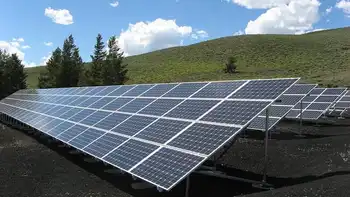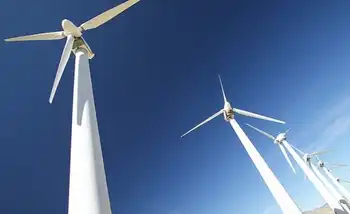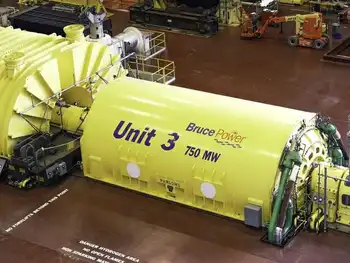Turbine developer feels the wind at his back
By Globe and Mail
Substation Relay Protection Training
Our customized live online or in‑person group training can be delivered to your staff at your location.

- Live Online
- 12 hours Instructor-led
- Group Training Available
Mr. Rowan became obsessed with wind energy in 1999 after watching a Discovery Channel program that said there was enough of it flowing over North American rooftops to power the entire continent.
"I thought, it's a shame that no one's taken advantage of that," recalls the chief executive officer of Enviro Energies Holdings Inc. based in Grimsby, Ont.
Engineers had long concluded that vertical axis wind turbines, which are typically mounted on roofs and use a propeller-shaped "sail" to produce electricity, would never work. Or, even if they did work, they would never produce enough power to deliver a sound return on investment. That valuable rooftop wind resource, it seemed, would remain untapped instead of offsetting the energy usage of residential or commercial buildings.
But Mr. Rowan, a serial entrepreneur who founded hospitality telecommunications services provider Canopco, wouldn't take no for an answer.
The former Canadian military computer and radar technician spent two years poring over a 2,000-page U.S. study that highlighted the reasons roof-mounted vertical axis wind turbines were inefficient sources of power.
Undeterred by the naysayers, Mr. Rowan boiled down the 2,000 pages into 11 reasons why they were a green energy dud. Then he looked for solutions to each challenge.
"I met with my friends and said, 'This is what we need to overcome,'" he recalls.
He and several partners founded Enviro Energies in 2007 to tackle the problem head on using about $5-million of their own money, including a few small investments from family and friends.
That seed money and the company's experiments produced key innovations such as an improved sail and generator system designed to function in low wind conditions by harnessing the turbulent air that typically flows over rooftops.
The roof-mounted sail rotates in the wind, spins a turbine and generates electricity that could be used to power an entire building. Power also could be transmitted back into the provincial/regional grid in exchange for credits to offset the building's consumption.
"[Ours] is completely different than any other wind turbine that's ever been built before," he says of the firm's low-speed magnetic vertical axis wind turbines, which range in price from $10,000 for a small 2.5-kilowatt model to nearly $50,000 for the largest 10-kilowatt unit.
"We have a low-rotational-speed wind turbine. That's a big deal. Most people don't realize how big a deal it is."
Customers have so far agreed. Mr. Rowan predicts Enviro Energies will close the year with sales of about $3-million, and he estimates revenue will reach $12-million to $15-million next year as sales to markets such as the United States, Sweden, Italy and Vietnam grow.
Enviro Energies is also actively licensing manufacturing rights to partners around the world to localize production and minimize shipping costs of the sizable turbines - the 10 kilowatt model, for example, spans eight metres in diameter.
Mr. Rowan also recently secured a $6-million investment to fund development of a one-megawatt wind turbine (with an estimated sticker price of $2-million) from a group in India, and says a licensing agreement with a firm in Vietnam is imminent.
Interest from deep-pocketed investors aside, the burning question is whether the turbines are worth the investment for eco- and budget-conscious business owners and consumers. Mr. Rowan says that each turbine, which has a shelf life of about 25 years, will generate enough electricity in four to 10 years (depending on the turbine's size, location and availability of wind) to justify its cost.
"If it takes 10 years to pay off, you still have 15 years of free energy coming in," he says. In theory, a 50-kilowatt vertical-axis wind turbine - which Enviro Energies is currently developing - could power a five-storey office building, Mr. Rowan says.
But skeptics argue that these performance claims are questionable because no standardized tests exist that could confirm the firm's power output estimates.
"Will [these turbines] produce a lot of electricity? I would say no," says Paul Gipe, a Bakersfield, Calif.-based renewable-energy industry analyst and author of the book Wind Energy Basics. Mr. Gipe points to a 2009 report by Britain's Energy Savings Trust, which monitored 38 building-mounted wind turbines for a year and found that they "exhibited generally poor output" due to inadequate wind speeds.
It boils down to a problem of physics that has consistently plagued small wind turbines, adds Tim Weis, a Gatineau, Que.-based engineer and director of renewable energy and efficiency policy for the Pembina Institute, a renewable energy advocacy group.
"If you try to put something on a rooftop or on top of a house, you get into areas where there are low winds and the physics dictate there's only so much energy there," he says.
In Mr. Weis's view, horizontal-axis wind turbines, which rely on long, slender blades mounted on tall towers to generate electricity, are a far more efficient means of producing renewable energy. He also points out that in jurisdictions such as Ontario where energy is relatively cheap, and where the feed-in tariff program pays more than five times the amount for solar power than wind energy delivered onto the provincial power grid, the former is a far more cost-effective investment.
These are criticisms that Mr. Rowan has heard time and again, and he says that delays in getting his turbines to market are partly due to time spent responding to each. He counters that Enviro Energies's technology is designed precisely for low-wind, high-turbulence rooftops and feels that successful third-party testing by Livonia, Mich.-based Roush Enterprises, as well as significant foreign investment, is proof that it works.
"Take our wind turbine and put it in straight-line wind conditions and the other turbines will outperform it. But we'll outperform them in turbulent wind conditions every time."
The man who once gleaned inspiration from a documentary program boldly proclaims that it could one day eliminate power bills for businesses up to the size of small manufacturers:
"We're not there yet," he says, "but give me another year and I'll have a solution operational that will do that."











